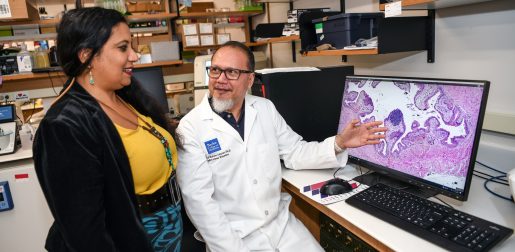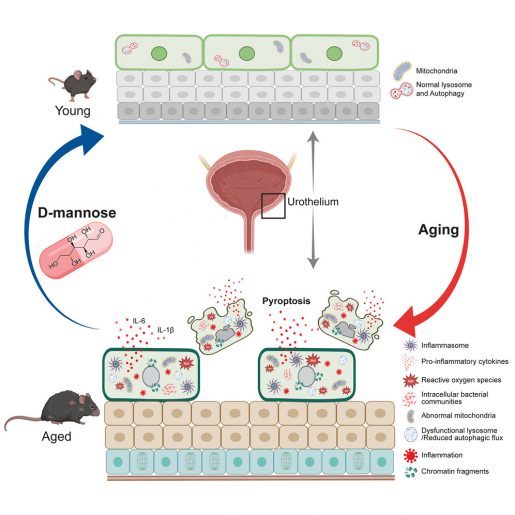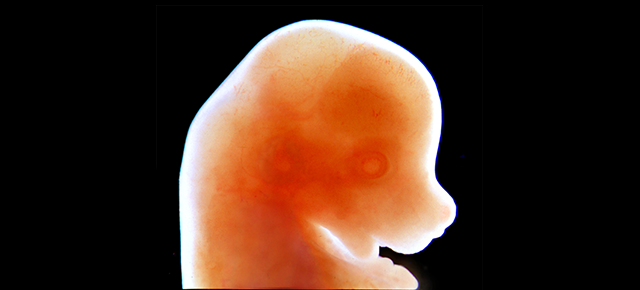D-mannose reduces age-triggered changes in urinary tract that increase susceptibility to UTIs
Many people say, “It’s no fun getting old,” as aging poses a number of challenges to the body’s well-being, one of the most important being an increased susceptibility to multiple diseases, including urinary tract infections (UTIs). The connection between aging and more prevalent UTIs is not well understood, but now researchers at Baylor College of Medicine have found an explanation.

“We began this study by comparing the functions of naturally aging cells in mouse bladders with those of younger animals, in the absence of a bacterial infection. Specifically, we studied urothelial cells, the cells that line the inside of the bladder where urine is stored,” said corresponding author Dr. Indira Mysorekar, professor of medicine – infectious diseases and E.L. Wagner, M.D., Chair of Internal Medicine at Baylor.
The aging bladder
The researchers investigated a process called autophagy that all cells naturally use to clean up old or defective cellular materials by digesting and recycling them in structures called lysosomes. “We found that the recycling process naturally slows down as urothelial cells age,” said Mysorekar, a professor in the Huffington Center on Aging. “Older cells accumulate larger lysosomes that are less effective at degrading cellular materials, which leads to their toxic accumulation inside the cell.”
Aged urothelial cells also accumulate more damaging reactive oxygen species (ROS) than younger tissues. “ROS are molecules that can harm tissues, and the redox response that normally neutralizes ROS in younger cells is dampened in aging urothelial cells,” said co-first author Dr. Arnold M. Salazar, senior staff scientist in the Mysorekar lab. “Consequently, an inflammatory process builds up, leading to cell death. Dead urothelial cells leave their location, exfoliating the bladder and disrupting its integrity, which further exacerbates age-related dysfunction.”

D-mannose reduces age-related changes in the bladder
Importantly, the researchers also discovered that treating aged mice with D-Mannose, a natural sugar, restores autophagy and mitigates ROS and urothelial cell shedding, suggesting that mannose supplementation could counter age-associated human urothelial dysfunction.
Mysorekar, Salazar and their colleagues then compared bacterial UTIs in older animals versus younger animals. “We found that aged mice have more bacterial reservoirs in the urinary tract and are more prone to spontaneous recurrent UTI than younger mice, suggesting that the age-related dysfunction of the tissue could explain the higher recurrence of UTIs observed in older age,” Salazar said.

“Collectively, our results demonstrate that normal aging affects bladder physiology, with aging alone increasing baseline cellular stress and susceptibility to infection,” said Mysorekar, also a professor of molecular virology and microbiology.
We suggest that mannose supplementation could counter age-associated urothelial dysfunction in addition to limiting recurring UTIs.”
Read all the details of this study in the journal Developmental Cell.
Other contributors to this work include co-first author Chetanchandra S. Joshi, Caihong Wang, Marianne M Ligon, Rayvanth R. Chappidi, Bisiayo E. Fashemi, Paul A. Felder, Amy Mora, Sandra L. Grimm and Cristian Coarfa. The authors are affiliated with Baylor College of Medicine and/or Washington University School of Medicine-St. Louis.
This work was supported in part by NIH grants (R01DK100644, R01AG052494, P20DK119840, and R56AG064634) and NIH training grants (T32AI007172, T32GM007200 and T32-AI007172). Partial support was provided by the Cancer Prevention and Research Institute of Texas (RP170005, RP200504 and RP210227), NIH/NIAID (1U19AI144297, NIH/NCI P30 shared resource grant CA125123) and NIEHS grants (P30 ES030285 and P42 ES027725).
Follow From the Labs on X @BCMFromtheLabs and Instagram!



